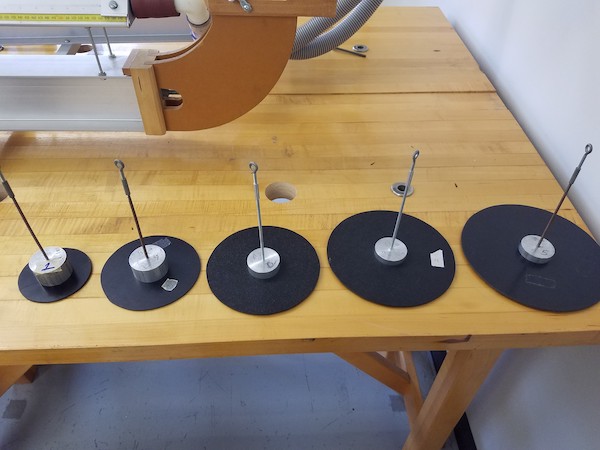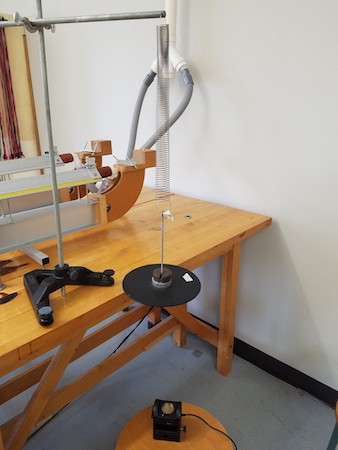Instructions
Worksheets
- E2C – Damped Harmonic Motion Worksheet [Microsoft Word]
- E2C – Damped Harmonic Motion Worksheet [PDF]
Overview
In this weeks experiment you will develop and study an analytical model that more accurately describes complex and realistic oscillations. Last week, you probably noticed that the amplitude of the motion of the mass on the spring decreased slightly over time. We ignored this effect, called damping and due to air resistance, in last week’s analysis. This week we will on purpose make the damping more pronounced by making the size of the oscillating mass larger to increase air resistance.
Experimental Measurements
 |
 |
| Figure 1: Masses 1 thru 5 | Figure 2: Experimental Setup |
The same spring (Spring A) that was used last week will be used this week. You can safely assume that the spring constant will be the same as in the Simple Harmonic Motion experiment. A set of 5 different masses, shown in Figure 1, were tested using the experimental setup shown in Figure 2. A sonic ranger was used to measure the position of the mass as it oscillated on the spring. The five objects had nearly identical masses, but had different sizes. The masses and radii of each are shown in the table below.
| Object # |
Mass kg |
Radius m |
Data
|
| 1 | 0.3748 | 0.101 | E2C-Mass1.txt |
| 2 | 0.3741 | 0.142 | E2C-Mass2.txt |
| 3 | 0.3749 | 0.175 | E2C-Mass3.txt |
| 4 | 0.3756 | 0.200 | E2C-Mass4.txt |
| 5 | 0.3741 | 0.225 | E2C-Mass5.txt |
The above table also includes links to data files for each mass that contain the position of the mass as a function of time as it was oscillating up and down above the sonic ranger position sensor. You will need to right-click on these files and save them to your computer. They can be loaded into Physics Data Assistant and fit to the model for an underdamped oscillator,
$$y = y_0 + Ae^{-\gamma t}\textrm{cos}(\omega t + \phi)$$
After determining the damping factor \(\gamma\) and the angular frequency \(\omega\) for each mass you will study how these damping coefficient \((b = 2 \gamma m)\) and the angular frequency depend on the size of the object. You will also add to your previous simulation from last week to add a damping term due to air resistance.

